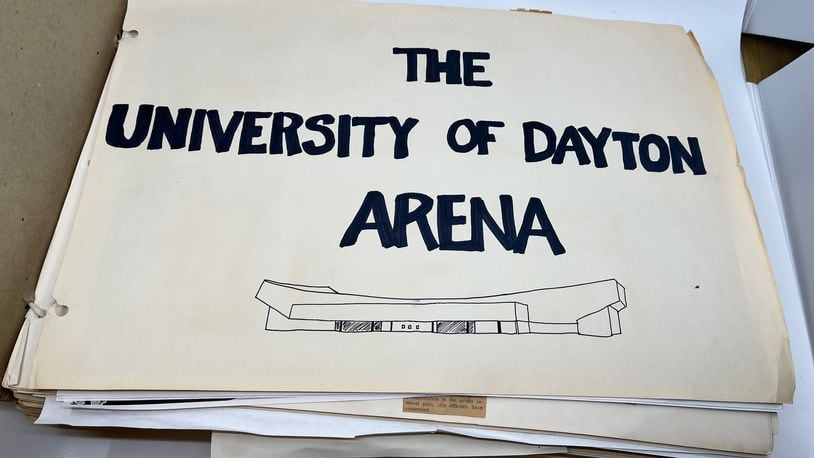That phrase, “The Epicenter of College Basketball,” originated before the 2013 NCAA Tournament in meetings of the First Four Local Organizing Committee. When I interviewed J.P. Nauseef, the chairman of the local organizing committee in its early days, for the book, I made sure he was OK with me using the phrase. He was all for it.
» PHOTOS: UD Arena images from ‘The Epicenter of College Basketball: A History of UD Arena’
As I wrote in the book, which is now for sale at UDArenaBook.com and at the UD Arena gift shop, the UD bookstore on campus and Flyer Spirit on Brown Street, I had personal reasons for doing it. My grandpa, Dr. James Leary, was a lifelong Flyer fan who took me to my first game at the arena in 1990. My parents, Mary and Jeff, had their wedding reception at the arena.
For the past 11 seasons and counting, I’ve chronicled many of the great moments in the arena’s existence, and I wrote extensively about the three-year renovation project that ensured the arena will stand for decades to come.
As much as I knew about the arena going into this project, which took me just short of two years, there were stories I uncovered during my research that were new to me.
Here are a couple short excerpts from the book:
• The key figure: Brother Joseph J. Mervar, UD’s business manager, sent (UD Athletic Director Tom) Frericks a note of thanks (after the arena’s opening). He told Frericks he wanted him to have something in his scrapbook that his children, grandchildren and great-grandchildren could read, and indeed that letter made it into the giant scrapbook Frericks kept.
The letter from Mervar reads, in part, “First of all, I want to thank you for what most people will overlook; that is the months of meetings and negotiations that produced only meaningless and worthless reports of things that would not work. There was a time, I recall, when your efforts were so sterile that you were ready to give up.
“Since there was no payoff on all this effort, I want to thank you for it anyway. It was real work. Most of all, I want to thank you for your perseverance. I cannot recall anyone trying as many alternatives to put a package together as you have. This arena made history before the drawings were completed. May the resulting monument shout thanks to you as long as it lasts. This should be your greatest reward.”
• The man who lived there: UD Arena would become a home away from home for thousands of Dayton fans in the decades to come. For one man, in the early 1970s, it really was home.
Charlie Rathburn moved into the arena just before it opened. His official job title was building security supervisor. He looked over the place after everyone went home, making sure the 100 or so doors were closed, and then unlocked each and every door in the morning.
Rathburn lived in a small first-aid room for the first three months and then moved upstairs. He had two couches, two end tables, a bed and a TV. The university provided him with a refrigerator and small stove.
“Everything a man needs,” Rathburn said.
• The arena go-kart: Tom Westendorf remembers long days at the office. He would sometimes work 60-80 hours per week with Gary McCans, the longtime ticket manager. They would blow off steam by doing goofy things to keep themselves sane.
“Someone donated a go-kart for Rudy (the mascot) to ride around the track at the football games,” Westendorf said, “and it was stored in the arena during the week. Gary and I decided we were going to have time trials in between the 200 and 300 levels, where you could walk around the whole concourse.
“Nobody ever crashed. We had a number of people try it out. I was out there with a stopwatch and everything.”
• The recruiting tool: The (Farrell) brothers also saw how the coaches used UD Arena in recruiting.
They sold the legacy and the history, Matt Farrell said, mentioning the fact of UD ranking in the top 35 in attendance every season since 1969-70 in multiple mailings to recruits every year.
“We leaned into the history and pedigree, the fans and the atmosphere,” Matt said, “and it just so happened to kind of be the historic place that it was.”
During (former coach Archie) Miller’s years, UD turned the seats on the floor behind the team’s bench into ticketed seats, Eric said, so they could place recruits there.
“They could see huddles,” Eric Farrell said, “They could see the atmosphere. That’s how we begin to leverage the arena — from the bird’s eye view down to the in-person view.”
About the Author
